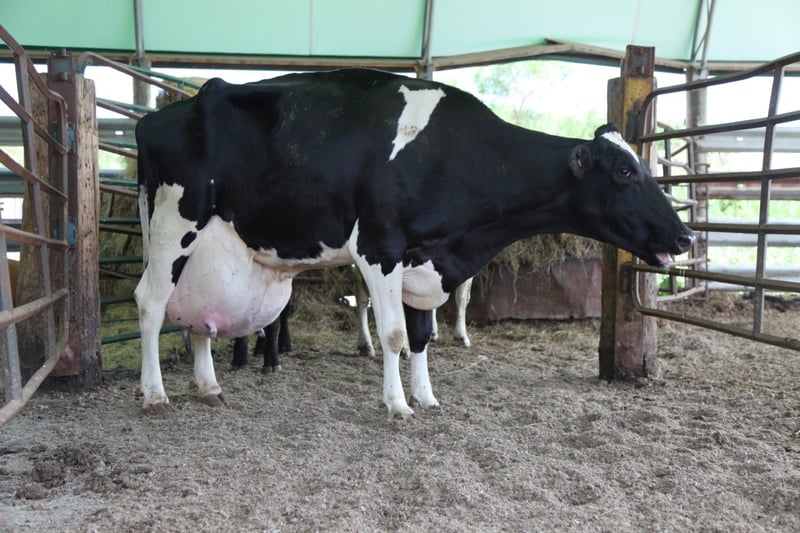
Cull dairy cows face a long, arduous journey to slaughter
Blog
An estimated 560,000 cull dairy cows are sent to slaughter each year, many of whom are in poor health and deteriorate quickly on the long journey.
At any given time, there are 1.4 million dairy cows in production throughout Canada. These cows are artificially inseminated only to have their calves taken away from them immediately after birth so that their milk can be sold for human consumption. They are milked repeatedly until they stop lactating, and the process is started all over again.
What is a cull dairy cow?
Once a dairy cow is no longer productive, is unable to get pregnant again, has injuries or compromised health, she becomes useless to the industry. These cows are deemed no longer economically viable to keep around, so they are sent to slaughter. Each year, 30-40% of the total dairy cow population becomes “cull cows”. That equates to approximately 560,000 dairy cows that are slaughtered annually.
In North America, cull cows are typically transported to auction (instead of being killed on the farm), where they are bought and then further transported to slaughter. Some cows are even sent to multiple auctions before finally being shipped to slaughter. A report by the National Farmed Animal Health and Welfare (NFAHW) Council indicated that in some cases, the time from farm to slaughter can be as long as 7-10 days.
Due to their poor health to begin with, many of these cows suffer during this long journey to slaughter.
What are the welfare issues faced by cull dairy cows?
Because cull cows often have underlying health conditions or injuries, they have an increased risk of deteriorating on the long journey to slaughter. Along the way, these cows are not given regular access to feed and water, and often not milked leading to painfully full udders, exacerbating their poor condition. Some cows sustain severe injuries along the way, and some do not survive.
One study found that there was a high prevalence of cull cows at auction with a low body condition (thin), with an abnormal gait (difficulty walking), or with hock injuries, all indicating poor welfare. This goes against industry standards and federal transport regulations that prohibits unfit or compromised animals from being transported. Sadly, there is minimal inspection, monitoring, and enforcement of these regulations at auctions.
Fortunately, there has been increasing attention paid to the management of these cull dairy cows. The Canadian Veterinary Medical Association (CVMA) published a position statement in 2018 opposing the long-distance transport of cull cows. The dairy industry itself acknowledges the problem of inappropriate shipment of compromised/unfit cows and is making efforts to educate farmers. Still, more work is needed to address this problem and prevent the needless suffering of these animals.
Cull dairy cows at an auction in Ontario, the cows appear thin and have very full udders.
How can we improve the welfare of cull dairy cows?
It is unacceptable that these cows suffer when good management decisions could prevent it.
Based on expert recommendations, World Animal Protection strongly recommends the dairy industry work with producers and other stakeholders to implement the following measures to prevent the needless suffering of cull dairy cows:
- Implement proactive culling: animals must be culled before they become compromised and at a higher risk of transport related deterioration.
- Increase accountability: producers must be held responsible for animals being transported in poor health. Strict penalties should be levied for shipping sick or injured cull cows.
- Ensuring cows are fit for transport, including be 'milked out' or dried off, fed and watered for weight gain, and rested.
- Work to make local slaughter or on-farm euthanasia a viable option for farmers to reduce the need for long transport.
- Implement better regulations and inspections at auctions to protect animals and prevent suffering.
- Improve conditions at auctions: including providing food & water, milking to full cows, and increasing euthanasia capacity.
How you can help cull dairy cows
Stay tuned for more information on this topic and how you can help us advocate for cull dairy cows.
In the meantime, one of the best ways to help farmed animals is to reduce the amount of meat and dairy you consume. Doing so will support a transition to a more humane and sustainable food system.
You can also make a donation to fund our work in Canada to demand better treatment for cows.
With your support, we will work to improve the health and welfare of dairy cows by pushing industry and other stakeholders to make the necessary changes to ensure the well-being of these animals is a priority.
